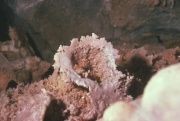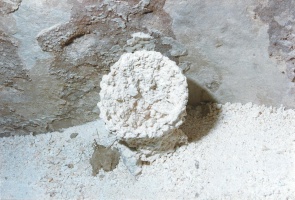Calcite (Inventory)/Conulite
From LagWiki
(Added a note) |
(Added another see also) |
||
| Line 3: | Line 3: | ||
The '''Conulite''' field of the [[Calcite (Inventory)|Calcite]] section should be used to record any observation of conulites. | The '''Conulite''' field of the [[Calcite (Inventory)|Calcite]] section should be used to record any observation of conulites. | ||
| - | Conulites are cone shaped calcite deposits that form in drip pits. When the material in which the drip pit formed is washed away, dissolved or removed by some means, what is left is a thin calcite cone or tube that once lined the inside of the drip pit. | + | Conulites are [[Calcite (Inventory)/Drip Pit Lining|drip pit linings]] that have been exposed by removal of the substrate. They are cone shaped calcite deposits that form in drip pits. When the material in which the drip pit formed is washed away, dissolved or removed by some means, what is left is a thin calcite cone or tube that once lined the inside of the drip pit. |
Conulites can form in a variety of materials including [[Vertebrate (Inventory)/Bat Guano|guano]], [[Floor (Inventory)/Sediment/Soil|sediments like mud or gravel]], [[Hydromagnesite (Inventory)/Moonmilk|moonmilk]] or even [[Gypsum (Inventory)/Beds, Massive|massive gypsum]]. All of these materials are soft or easily eroded and thus subject to drip pit formation and later removal which may leave a conulite. | Conulites can form in a variety of materials including [[Vertebrate (Inventory)/Bat Guano|guano]], [[Floor (Inventory)/Sediment/Soil|sediments like mud or gravel]], [[Hydromagnesite (Inventory)/Moonmilk|moonmilk]] or even [[Gypsum (Inventory)/Beds, Massive|massive gypsum]]. All of these materials are soft or easily eroded and thus subject to drip pit formation and later removal which may leave a conulite. | ||
| Line 14: | Line 14: | ||
==See also== | ==See also== | ||
| + | *[[Calcite (Inventory)/Drip Pit Lining|Drip Pit Lining]] | ||
*[[Karren (Inventory)/Drip pit, carbonate|Drip pit, carbonate]] | *[[Karren (Inventory)/Drip pit, carbonate|Drip pit, carbonate]] | ||
*[[Karren (Inventory)/Drip pit, gypsum|Drip pit, gypsum]] | *[[Karren (Inventory)/Drip pit, gypsum|Drip pit, gypsum]] | ||
Revision as of 03:38, 2 April 2012
The Conulite field of the Calcite section should be used to record any observation of conulites.
Conulites are drip pit linings that have been exposed by removal of the substrate. They are cone shaped calcite deposits that form in drip pits. When the material in which the drip pit formed is washed away, dissolved or removed by some means, what is left is a thin calcite cone or tube that once lined the inside of the drip pit.
Conulites can form in a variety of materials including guano, sediments like mud or gravel, moonmilk or even massive gypsum. All of these materials are soft or easily eroded and thus subject to drip pit formation and later removal which may leave a conulite.
Conulites are usually small, about 15 cm in depth with thin walls up to 1 cm thick. In massive gypsum, they may be more tubular than conical as massive gypsum forms tubular drip pits. If filled with water, they may resemble a bird bath and may sometimes resemble a fan. They may have a flared and fluted edge which once extended over the surface of the substrate material.
Moonmilk conulite. Note the bat mummy near the base. |
See also
References
- Hill, Carol; Paolo Forti (1997) Cave Minerals of the World (Second Edition ed.) National Speleological Society pp 57-59 ISBN: 1-879961-07-5
- Palmer, Arthur N. (2007) Cave Geology CAVE BOOKS, Dayton, OH p 284 ISBN-13: 978-0-939748-66-2, ISBN-10: 0-939748-66-5


